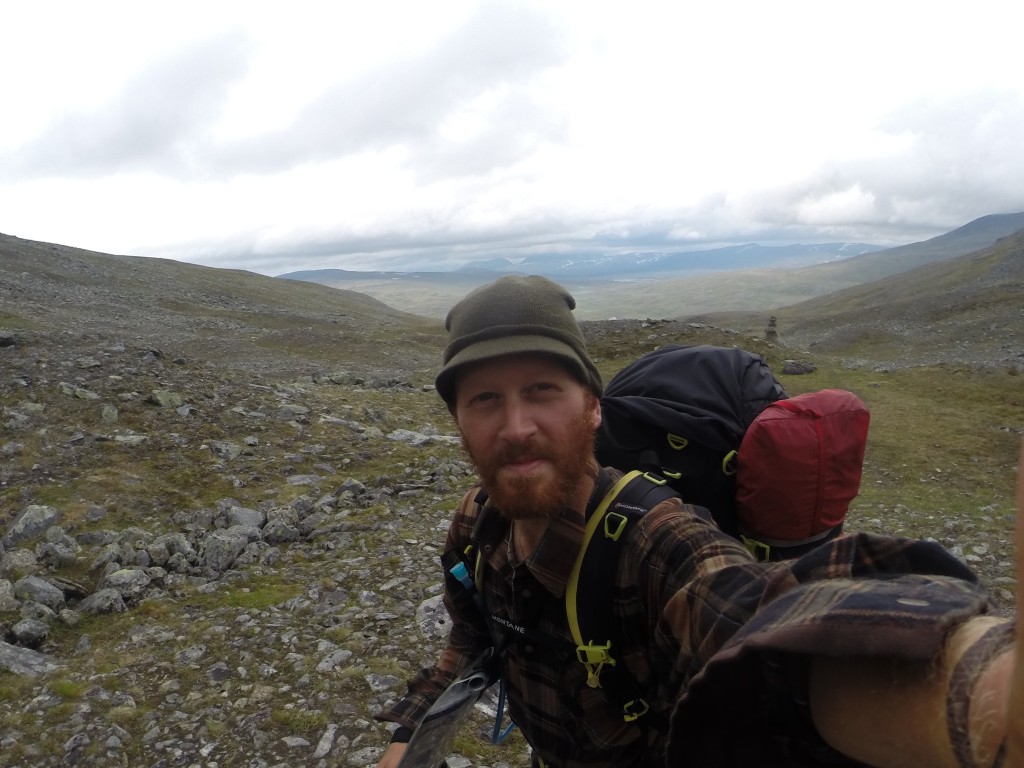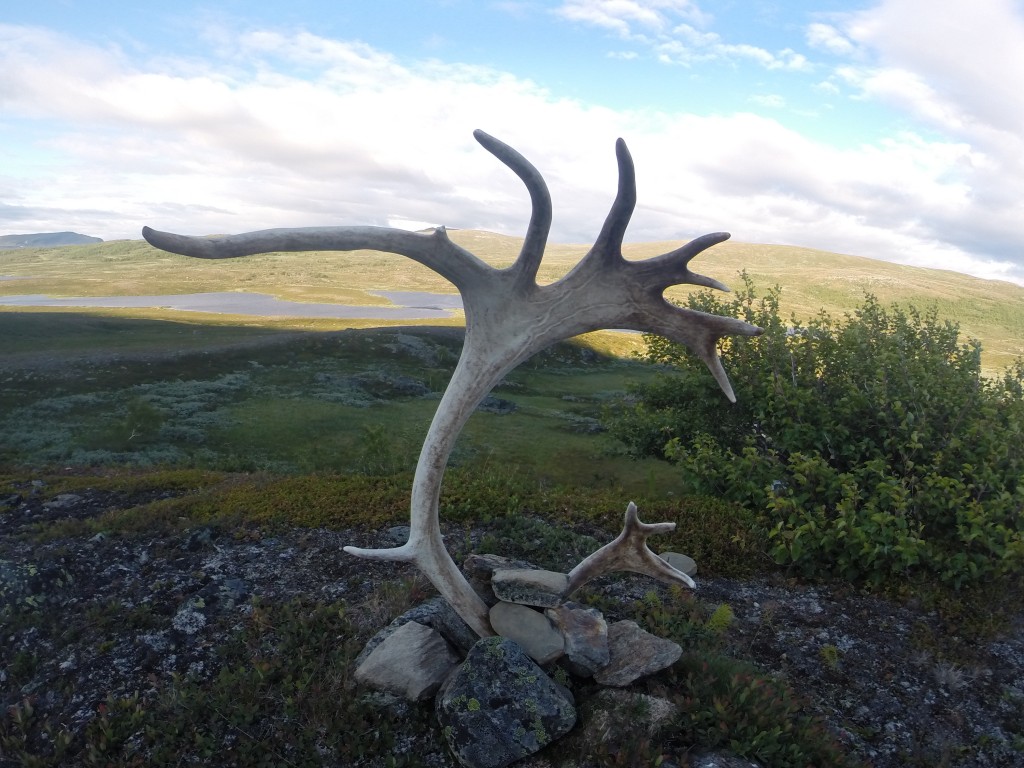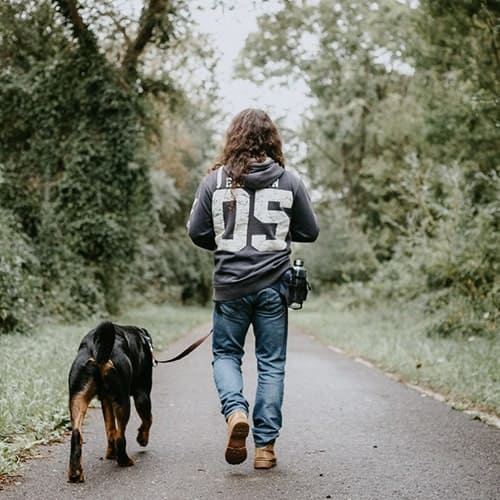I’m finally back at my cottage, conspicuous from afar in our well-kept village on account of its wild, untrimmed hedges and a little front garden so overgrown that you can barely see the door. Across the road, my old Volvo starts up but then disappointingly refuses to move anywhere. The grass reaches halfway up the wheels and an attempt to check the oil level reveals a dipstick caked in reddish-brown muck. Bills for Mr Jolyon Braime (or variants thereof) piled up in the porch. It feels like a lot longer than two months since I locked up and headed out. Whitby is seething with holidaymakers and the mountains of northern Scandinavia seem very far away.
Inevitably it’s taking a little time to adjust to being back after such a long adventure. It’s grand to be home but I’m missing that reassuring feeling of covering ground, and especially the sense of anticipation you get each morning when you’re on the trail. That sensation of the day’s adventures and challenges looming ahead of you.
I have had a bit of time to think about the whole thing, though, and with the benefit of hindsight I thought it might be worth evaluating some of the decisions I made as part of my planning. I’m going to write a separate (no doubt mammoth) blog about my gear, so keep your eyes out for that too if you’re interested.
Route
I was glad I chose to follow the red needle north, from Grövelsjön to Treriksröset. It was the safer direction, considering my early start date and the unusual snow conditions, and though two early-season Green Bandits did elect to start from Treriksröset, they were both much more experienced than I am. It was occasionally a bit inconvenient walking the Kungsleden in reverse (most people start in Abisko rather than Hemavan, and it works better that way), but my compensation for this was my final week following the Nordkalottleden from Abisko to the finish line. It was absolutely first-class hiking, and it made for a real high note to end on.
Working my way backwards, the decision to follow the whole Kungsleden as my highway to the north was one which worked for me on this occasion. As a newcomer to northern Sweden it was safe and very fulfilling, and much of it was reasonably easy walking, plus there were a lot of interesting people to talk to. That said, if I were undertaking it all over again I might be a little bit bolder in my route planning. There is a lot of very tantalising territory to the west of the Kungsleden’s middle section, and though it would undoubtedly have been much more challenging, it would have been fun to get my feet dirty. Then again, perhaps that’s another trip for another year.
Further south, one of my real highlights was the backcountry stretch between Gäddede and Klimpfjäll. Gustav and I deliberated quite long and hard over which way to go (there’s a lot of choice) and we eventually decided to take a lesser-trodden option – a sort of right-angled route heading straight east out of Gäddede then turning more or less dead north round the Sami settlement at Jougdaberg. On balance it’s probably significantly slower than the more usual Green Bandit choice of going via Ankarede, and the summer paths in the area were truly atrocious, but there was some gorgeous mountain walking hidden away on those neglected trails round Härbergsdalen and Södra Borgafjällen. Our strenuous but exhilarating day in the sunshine on the deserted slopes of Aerhtsege may well have been my favourite of the whole trip, and I felt like we were amply rewarded for our troubles.
And then there is the road question. North-west of Åreskutan, at the beginning of the second stage, there is a stretch of thickly-forested road walking that lasts the better part of six days as you begin by picking your way round the inconveniently-placed lakes of Kallsjön and Juvuln. It was unquestionably my low point of the trip, albeit almost completely on a mental level. To simply describe it as ‘boring’ is to understate the issue, since two of the most enjoyable things about long-distance hiking are your sense of progress and the endlessly rich variation of the trail. Reduce both of these substantially, and you sometimes feel like you might as well get the bus. Of course in such a situation you find the positives, of which there were many, but I still found it hard.
Looking back on it though, I wonder whether it might have been worth giving more consideration to the other possibility, which was to follow a much wilder, trackless line northwards through Norway. I initially rejected this option partly on account of a lack of confidence in my off-trail navigational skills (I’m fine in the mountains, but I get nervous when I haven’t got decent landmarks to get bearings off, as is often the case in dense woodland), and partly after reading a line on Mark Waring’s blog. While planning his own Green Ribbon in 2013, he’d spoken to long-distance hiking writer Chris Townsend, who had taken just such a route on a previous trip, and ‘declared it utterly exhausting’. From such an experienced fellow, it’s not exactly a ringing endorsement.
But then again, the road was pretty exhausting too, and some of those who’ve ventured away from it seem not to have regretted it. Mark himself took some more adventurous shortcuts through the woods (and enjoyed them), while I was intrigued to read a blog by Mats Jacobsson, an unofficial Green Ribboner who was also on the trail this summer. He took the wild route and, while it doesn’t sound like he had it particularly easy, he did have quite an adventure. His blog on the subject (in Swedish) makes interesting reading, but I did also drop him an email asking what he reckoned to his own route choice, and he was good enough to reply:
I can’t really recommend the route I took, even if I liked it. There were some really hard days, one with ten hours in a swamp […] However, if I was to walk that route again, I would either plan a few extra days and walk Norwegian trails between huts, perhaps all the way up to Hemavan (Norwegian mountains are nicer and so are the cabins, check out ut.no). Or I would go to Duved and over Mullfjället and somehow get to Skäckerfjällen where there are some trails and then walk through the Lierne National park in the south east corner in the little Norwegian square south of Gäddede. This option might include a day or two on roads or through some wetlands.
Anyway, I’m not saying I’d definitely find an alternative to the road walking. Only that I’d think about it a little more seriously next time.
Food and supplies
I didn’t post supply boxes ahead, and I didn’t miss them. There were big supermarkets in Åre, Gäddede and Hemavan, with additional smaller stores in Rötviken, Valsjöbyn, Klimpfjäll, Ammarnäs and Björkliden, among other places. I also had the fall-back option of the shops at the STF huts, but I only used these very rarely for the odd bag of crisps or pack of crispbread. By making my resupplying a bit more ad-hoc, I gave myself a smidge more flexibility and reduced the likelihood of over-supplying (guys with boxes always seem to be offloading surplus food), though I still managed to get carried away when I overloaded myself in Hemavan.
The only place where I ended up paying higher prices for my resupply was in Abisko, where it was an 8km round trip to the supermarket, versus a few metres to the well-stocked but pricey STF shop. I decided that after 49 days, it was worth a few quid to arrange things so that any kilometres remaining in my legs were spent going in the right direction.
In terms of what I ate, I experimented a fair bit, but by the end I had a routine which seemed to work.
I usually started the day with zip-lock bags of porridge. I’d got them ready-mixed with milk powder, salt, sugar and either chocolate powder or dried apricot and cinnamon, so I just had to add hot water that I’d put in the Thermos the night before, reseal the bag, wait five minutes and they were ready to go. Lunch/elevenses/second breakfast/afternoon tea/high tea etc was crispbread and squeezy cheese (Swedes have a remarkable range of both), supplemented with jerky and biscuits or chocolate.
Dinner was packet soup (the Swedish blueberry soup is especially good for replenishing energy) followed by some kind of pasta. Those dried expedition meals that you can buy are usually pretty good, but they’re just too expensive for a trip of this duration, while the Pasta ‘n’ Sauce-type sachets that I usually favour for hiking trips simply weren’t big enough to satisfy after such long days. I tended to measure out very generous portions of standard quick-cook dried pasta, then stick them in zip-lock bags with powdered sauces and sometimes chopped dried meat or dried onions. For variation I sometimes had instant mash and gravy, or savoury rice. None of it particularly joyous, but it got the job done, and as my arctic guide friend Christian K was once fond of saying, hunger is the best cook.
Despite my best efforts to eat far more substantially and regularly than on any previous trip, I still struggled to get enough calories down me. Mountain walking with 20kg on your back for such a prolonged period is just a demanding old game. I lost a bit over two stone, and by my final week I was getting very lean. This meant that my energy levels were entirely and immediately dependent on how much I ate, which was rather unfortunate since I’d been a bit light on my restock in Abisko. Still, with some tactical mealtimes my food (just) lasted, so no harm done.
The one thing I would deal with differently in hindsight is my maps. Fifteen Lantmäteriet maps is an unnecessary amount of weight, and though one method for combating this might have been to use the double-sided mountain maps from Calazo, I reckon some judicious use of the postal system would be the easiest way.
Some final thoughts
Physical fitness plays its part, of course, as does sheer luck, and it’s been sad to see all the strong walkers who’ve gone out with injuries this summer. But calamities aside, I reckon a trek of this length is all about psychology.
I had some good fortune in this regard. During some of the most demoralising stretches I had Gustav’s irrepressible high spirits to help lift my own (incessant humming and singing being, on such occasions, much less annoying than you’d imagine), while at other times I found myself spurred on by people I met along the trail. Doubt and confidence are equally infectious, and one thing that really struck me was how positive (without exception) the Swedish people I met were about my chances of getting to Treriksröset. I suppose it probably sounds a bit insecure, but you have a lot of time to mull things over when you’re walking, and sometimes it gives you a real lift when someone dismisses your doubts or tells you that you’re still looking pretty fresh after 40 days of walking, even if they’re lying through their teeth. A bit of scepticism at a similar juncture might have had a quite different effect.
There were a few phrases that kept coming back to me over the course of the walk, and the first of these was from the warden at Rogenstugan, where I stayed on my second day. At the time I wasn’t at all sure whether I had enough time to get to Treriksröset, but she thought about it for a moment, then said, ‘I think you can make it. But you have to really want it.’ And I think she was right. You need to enjoy the experience as it happens, but it’s a long game and there are also times when you just need to fixate a bit on a goal, even if it’s very far off. Otherwise you’d just pack it all in after the first rough day.
The other words that stuck with me were from Torkel, one of the organisers of the Green Ribbon, who ran into us by chance outside Åre. As we were parting ways, he said, ‘Remember it’s a long way north, so just take it easy, don’t stress.’ Doesn’t sound that profound, but it sort of was. The worst days I had were the ones where for whatever reason I rushed myself beyond my natural pace. And you’re not going to make anything better by getting wound up about demoralising things like incessant rain or vicious mosquitoes doing what they were put on this earth to do. Worry just isn’t sustainable, and you have to get used to taking things in your stride. If you’re stressing then you’re not enjoying it, and if that goes on too long then you’re going to end up giving up. There’s no point in walking something as long as the Green Ribbon if it isn’t fun.
So tenacity and serenity play their part, and for my money, a bit of optimism is the final ingredient in a memorable adventure like this year’s Gröna Bandet. I leave you with my Swedish walking buddy’s golden rule of mountains.
‘I know it’s always further than it looks. But it doesn’t look that far…’



Really interesting to read this.
I think the perfect route is the one that you finish, you did that whilst others didn’t (either through bad luck or perhaps lack of preparation). But that’s the beauty of a walk like this, there are a lot of potential variants. You, despite not speaking Swedish or having been up there before, undertook a variant which sounds really interesting.
The vexed question of the roads in Jamtland. I think it’s largely unavoidable, at least for a few days. As your respondent said you’d have to go quite far west into Norway to pick the perfect line. I had a day ‘cross country’ between Valadalen and Duved, that was horribly hard with forest and bog. I was clear after that that trying to get to Skäckerfjällen with a few more days of that would not be good and might start to exhaust early on in the walk with future consequences. You would grind out those miles.
Lierne though is a good option. My penultimate day to Gaddede went through that, I must be the only Grona Bandare who hasn’t seen ‘that waterfall’!
I’m still surprised more people have not gone my way from Hemavan northwards. It wasn’t that difficult, I had two days off trail with plenty of natural features to ‘handrail’ off. I had a massive mountain area all to myself and I had one lake to cross (Mavas) where you summon a boat. Happy Days!
Well done again Joly. I hope you explore Sweden more and more.
Mark Waring
Cheers Mark! I think you’re maybe right about the road walking, and the argument about not giving yourself a really rough time early on in the walk is a compelling one.
If it makes you feel any better, it’s some hours down a very overgrown, mosquito-infested trail to get to ‘that waterfall’, and I did spend most of it wishing I’d stuck to a route that kept me above the treeline (until I saw the waterfall, at which point I swiftly changed my mind).
I’d also definitely be tempted by your route north from Tarnasjon. Another year…
indyjols